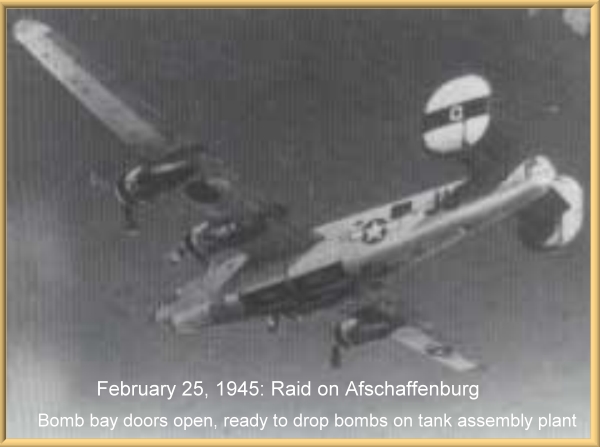No.
Place
Date
Remarks by Owen
Geographic Information
218
Magdeburg
Feb. 02-1945
February 3: Magdeburg
The "Siege of Magdeburg" began with this attack by 39 planes. Magdeburg was a massive oil refinery 75 miles west of Berlin. The lead navigator's plane received a flak hit which knocked out an
engine, but they were still able to get the group over the target. Flak severely damaged "Lil Snooks" (42-94936), and it's crew bailed out. 9 landed in Allied occupied territory and 1 was taken
prisoner.
A city of central Germany on the Elbe River west-southwest of Berlin. Known as early as 805, it was chartered in the 13th century and became one of the chief cities of
the Hanseatic League. Magdeburg was severely damaged during World War II.
224
Siegen
Feb. 19-1945
February 19: Siegen
39 planes hit the marshalling yards with unobserved results.
A city of west-central Germany east of Cologne. The birthplace of the painter Rubens, it is today heavily industrialized.
229
Aschaffenburg
Feb.
25-
1945
A city (1989 est. pop. 62,100), Bavaria, S central Germany, on the Main River. Its manufactures include clothing, machine and precision instruments, and colored paper.
Once the location of a Roman garrison and later of a Frankish castle, Aschaffenburg passed to the archbishopric of Mainz in the 10th cent. The imperial diet met there in 1474. It changed hands several times
during the Thirty Years War (1618–48) and was stormed in 1672 by the French marshal Henri Turenne. It passed to Bavaria in 1814. Noteworthy buildings include a 12th-century church and a 17th-century
castle.
February 25: Afschaffenburg
"Queenie", with bomb bay doors open, about to drop on a tank assembly plant

230
Berlin
The group led a large force as 3,000 tons were dropped on the German capital with unobserved results.
The capital and largest city of Germany, in the northeast part of the country. Founded in the 13th century, it was the capital of the kingdom of Prussia from 1701 and the capital of the German Empire (1871–1918), the Weimar Republic (1919–1932), and the Third Reich (1933–1945). The city was divided between 1945 and 1990 into East Berlin and West Berlin, which division grew out of the zones of occupation established at the end of World War II. The Berlin Wall, a wire and concrete barrier, was erected by the East German government in August 1961 and dismantled in November 1989.
232
Meschede
Feb. 28-1945
31 planes attacked a foundry with unobserved results.
233
Augsburg
Mar. 1-1945
9 planes bombed the Messerschmidt plant through cloud cover.
A city of southern Germany west-northwest of Munich. Founded by Augustus as a Roman garrison c. 14 B.C., it was a major commercial and banking center in the 15th and 16th centuries.
239
Betzdorf
Mar. 8-1945
18 planes attacked the marshalling yards with unobserved results.
247
Henningsdorf (Berlin)
Mar. 18-1945
Aborted, #1 Engine out Near Magdeburg
The Borsig Locomotive works was the target. the group missed, but did damage to other industrial buildings in the area.
257
Steder (Brunswick)
Mar. 31-1945
Steder was bypassed.
March 31: Brunswick
The armament works was bombed through heavy clouds.
259
Bayreuth
Apr. 5-1945
April 5: Bayreuth
9 planes hit the marshalling yards. 13 planes flew with another group and hit their targets. "Pin-Up Girl" (42-94941) was shot down by anti-aircraft fire, killing 4 crewmen. 4 more were taken
prisoner, though one escaped.
A city of east-central Germany northeast of Nuremberg. Richard Wagner lived here from 1872 to 1883 and designed the opera house used for the city's internationally famous music festivals.
264
Rechlin
Apr. 10-1945
April 10: Rechlin airfield
32 planes attacked and good results were reported.
265
Regensberg
Apr. 11-1945
April 14: Royan area, France
Each plane carried 4 2,000 pounders, and no guns or gunners to conserve weight, as the group bombed German defensive positions guarding the port of Bordeaux.